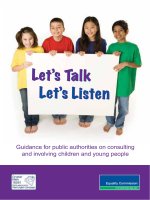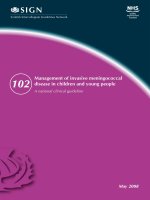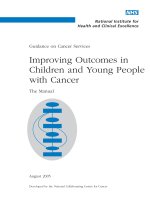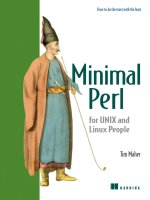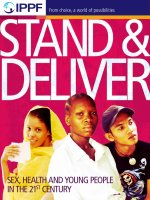Healthy futures for children and young people through an Energy Bill Revolution doc
Bạn đang xem bản rút gọn của tài liệu. Xem và tải ngay bản đầy đủ của tài liệu tại đây (425.01 KB, 8 trang )
June
www.ncb.org.uk June 2012
Healthy futures for
children and young
people through an
Energy Bill Revolution
NCB
Fuel Poverty and
Child Health and Wellbeing
2
q
Introduction
With gas and oil prices set to rise again next winter, even more families will suffer
financial hardship as they struggle to keep their homes warm and protect their
children’s health. The most cost effective way to help families cut their energy bills
and bring people out of fuel poverty is to improve the energy efficiency of their
homes.
This is why the National Children’s Bureau (NCB) is supporting the Energy Bill
Revolution campaign, calling on government to use the money it gets from carbon
taxes to make homes warmer and cut energy bills for children and their families.
NCB is working with children and young people to ensure the voices, stories and
views of children and young people are heard clearly throughout this campaign.
Fuel poverty
According to the World Health Organisation, an adequate standard of heating in the
home is 21°C in living areas and 18°C in bedrooms. A family is considered ‘fuel
poor’ if they need to spend more than 10 per cent of their income to meet that
standard and keep their home warm.
How many families are fuel poor?
In 2011, 6.4 million households in the United Kingdom were fuel poor, of which
over one million are families with children under 16.
Certain groups of children are more likely to be affected by fuel poverty and
therefore more likely to live in a cold or damp home. Over a quarter of lone parent
families are fuel poor
1
. And, children whose parents have a low income, who live in
“I joined the Energy Bill Revolution campaign because I wanted
to make a difference and I believe no-one should live in fuel
poverty - especially in a rich country like Britain". Kiran, 14,
NCB Young Fuel Poverty Champion
"What prompted me to get behind the Energy Bill Revolution
campaign is when I heard that children are living in cold and
damp environments and are catching illnesses and diseases
which are making them have time off school". Mariyam, 12,
NCB Young Fuel Poverty Champion
3
a rural area, who have a black mother, or who have a long-term illness are more
likely to see their families struggling to pay their energy bills
2
. The levels of fuel
poverty also vary from region to region
3
.
A 2012 survey of Barnardo’s services suggested that along with families with young
children, many disadvantaged young people in the 16 to 24 age group who are
living independently are struggling to pay their fuel bills and living in cold homes
4
.
How does living in fuel poverty affect children and young
people?
For a child, living in fuel poverty means growing up in a home that is cold and
damp. This will have a real effect on a child’s health, learning and enjoyment of life.
Health
The health and wellbeing of children is affected by living in cold homes at all stages
of their development. For infants and children the impacts are primarily on their
physical health while the mental health of adolescents is affected more.
Children living in cold homes are more likely to:
suffer from asthma, bronchitis and other respiratory illness, and to have more
severe symptoms
have a poor diet and lower than average weight gain in infancy
5
experience mental health problems in adolescence
have more and more severe colds and flu
Children living in cold homes are more than twice as likely to suffer from a variety
of respiratory problems compared to their peers living in warm homes
6
More than one in four adolescents living in cold housing are at risk of multiple
mental health problems compared to one in 20 adolescents who have always lived
in warm housing
7
Infants living in fuel poor homes are 30 per cent more likely to be admitted to
hospital or primary care facilities
8
54 per cent of all parents are worried that their children’s health will suffer because
their house is too cold this winter
9
4
Education and other effects
The combination of being unwell and poor housing conditions means that some
children living in fuel poverty struggle to get on with their school work, affecting
future employment opportunities
10
. Living in overcrowded or damp housing means
children are more likely to miss school
11
and children living in inadequately heated
accommodation often have no warm place to complete their homework. They may
also miss out on lessons due to ill health brought on by their living conditions which
is particularly concerning for teenagers approaching exams.
The increasing costs of gas and electricity means families are having to cut back on
other outgoings, such as paying for food, clothing and leisure activities
12
. Children
who live in fuel poverty are more likely to experience problems within the family.
Some may seek respite elsewhere exposing them to potential physical, mental or
emotional harm
13
.
Of course, children will also suffer indirectly from the effects of fuel poverty on their
parents who might themselves experience respiratory problems or feel stressed as
they struggle to pay the energy bills.
Almost a third of households with a disabled child and where no one works has
gone without heating because they cannot afford it
14
Over 90 per cent of respondents to a Barnardo’s survey reported families were
cutting back financially to pay for energy bills, with 74 per cent cutting back on
food; 84 per cent on heating and 60 per cent cutting back on buying clothes
15
q
“I worry. I can’t put the heating on like everybody else can … If
my son or I get sick, the asthma just flares up, and if it’s not
controlled quite quickly either he or I will end up in hospital.”
Anna, mother of two, quoted in Rising Energy Costs: The Impact on
Low-income Families (Save the Children)
“When my friend comes round he says [my home] stinks and
when I go to school this boy says my clothes stink but Mummy
washes them.”
Ben, 8, quoted in Chance of a lifetime: the impact of bad housing on
children’s lives (Shelter)
5
67 per cent of children who persistently lived in cold homes had not had a holiday
in the past year compared to 50 per cent who lived in a cold home on a short term
basis
16
10 per cent of children living in cold homes felt unhappy in their family, compared
to 2 per cent of those living in warm homes
17
55 per cent of all parents are worried about being pushed into debt if they can’t
afford their energy bills
18
What is the government doing?
Fuel poverty
Recognising the particularly negative impact of living in cold and damp homes on
children, the UK government has a legal duty to eradicate fuel poverty in England
by 2016
19
, and to reduce CO
2
emissions by 80 per cent by 2050
20
.
Currently, the government helps vulnerable private sector households improve the
warmth and energy efficiency of their home through its Warm Front scheme in
England
i
. However, this scheme will come to an end in 2013. Furthermore, in the
final two years of the scheme, eligibility is restricted so that only those families in
receipt of benefits and with children under the age of five are eligible for support.
From the end of 2012, the government will promote energy efficiency in private
homes through its new Green Deal programme. Energy companies will finance the
upfront costs of making homes more energy efficient and households will pay back
the energy companies providing the Green Deal through charges on their reduced
energy bills over the period of the finance deal. Only households where the savings
i
In Northern Ireland there is the Warm Homes scheme, in Wales Nest and in Scotland the
Energy Assistance Package.
q
“No-one can understand fuel poverty unless they have lived in
it. Fuel poverty is when you wake up to find you have no gas,
no money and two days ‘til payday. You have to feed cold food
to your children and wrap them up in coats, gloves and scarves
indoors or trail them round the shops all day to keep warm”.
Anonymous
6
on energy bills are greater than the cost of the energy efficiency measures will be
eligible for the Green Deal.
Despite not having to pay upfront, taking part in the scheme will be a challenge for
low-income families who may be eligible but do not want to take on more debt.
There are also concerns that families in hardship will continue to under heat their
homes to keep costs down, and that it will be challenging to secure energy
efficiency measures for the ‘hard to heat’ housing stock – such as homes with solid
walls and no loft insulation.
It is therefore welcome that the government has proposed the Energy Company
Obligation, a fund that will help families who cannot benefit from the Green Deal.
However, there are real concerns that, without greater financial support, the
government’s current plans will not succeed in tackling fuel poverty among all the
families affected.
Research suggests that, unless government policies change, there will be 9.1 million
fuel poor households in the UK in 2016, compared to 6.4 million in 2012
21
. This
takes us nowhere near the government’s target, and marks an increase of over a
third in the number of households, including those with children, struggling to pay
their energy bills.
Improving the wider factors that promote good health
Alongside its commitments to tackle fuel poverty, the government has
acknowledged the negative effects of health inequality – whereby those on lower
incomes are more likely to have poorer health – and the need to address the wider
environmental factors, such as fuel poverty, that contribute to the gap in health
outcomes.
The new Health and Social Care Act requires the Secretary of State for Health to
work to reduce health inequalities, and similar duties are placed on key players in
the health system, including the NHS Commissioning Board, clinical commissioning
groups, and Monitor the health regulator. By transferring responsibility for public
health to local authorities, the government has recognised the importance of a
range of local authority services – including housing, planning and environment – in
supporting healthy living in local communities. In addition, the public health
outcomes framework – used to hold public health services to account – includes a
range of outcomes dealing with the wider factors that affect health and well-being,
such as access to green space, housing and importantly fuel poverty.
The Energy Bill Revolution: investing in energy efficient
homes
Fuel poverty is caused by a combination of three key factors: household income, the
cost of energy and the energy efficiency of the home. Research has indicated that
the amount of energy needed to heat a home is more amenable to change than
income and fuel prices, which are subject to the market
22
. Improving fuel efficiency
7
of homes is therefore an effective way to achieve a permanent and fair solution to
fuel poverty, while also reducing harmful CO
2
emissions.
We are calling on government to take the money it receives by charging companies
for the damage their carbon emissions cause (carbon tax revenues), and invest it in
making our homes super-energy efficient. We want to see this investment targeted
at families who struggle hardest to heat their homes. The government is set to
receive £64 billion from carbon taxes over the next 15 years. This would provide
funding of £4 billion a year on average to be used on making homes super-energy
efficient.
Using carbon tax revenues would provide sufficient resources to lift all households
out of fuel poverty by 2027, cutting household bills by £310 per year, as well as
helping to cut carbon emissions and create new jobs. 600,000 homes could be
treated every year and an average grant of £6,500 could make all households living
in fuel poverty super-energy efficient.
The Energy Bill Revolution: investing in a healthy future for
our children
Making homes more energy efficient means children and young people will be
growing up in comfortable homes, protected from the negative effects of cold
and damp housing on their health and learning. One study found that home
energy improvements reduced the number of sick days off school by 80 per cent
for children with asthma or recurrent respiratory infections
23
.
As homes account for 25 per cent of CO
2
emissions in the UK, making homes
super-energy efficient will also help us to reduce air pollution, helping us to halt
global warming and its long-term effect on children’s health and well-being.
Please support the campaign to secure warmer homes for children and young
people by signing our petition at www.energybillrevolution.org
The Energy Bill Revolution is an alliance of more than 90 leading charities, unions,
consumer groups and businesses – including National Children’s Bureau, Save the
Children, Barnardo’s, The Children’s Society, National Pensioners’ Convention,
Consumer Focus, The Co-operative Group, USwitch, Kingfisher, IKEA, Asda,
Kingspan, National Energy Action, Macmillan Cancer Support, TUC, GMB, NUS,
Unite, UNISON, FMB, RIBA, The Centre for Sustainable Healthcare, the Association
for the Conservation of Energy, and Friends of the Earth. To find out who’s on
board, visitwww.energybillrevolution.org/whos-behind-it/
1
Consumer Focus Estimated UK fuel poverty levels in November 2011
(last accessed June 2012)
2
Marmot Review Team (2011) The Health Impacts of Cold Homes and Fuel Poverty London: Friends of
the Earth/Marmot Review Team
8
3
Consumer Focus Estimated UK fuel poverty levels in November 2011
(last accessed June 2012)
4
Barnardo’s (2012) Priced out The plight of low income families and young people living in fuel poverty
Essex: Barnardo’s
5
Liddell, C (2008) The impact of fuel poverty on children Belfast: Save the Children
6
Marmot Review Team (2011) The Health Impacts of Cold Homes and Fuel Poverty London: Friends of
the Earth/Marmot Review Team
7
Marmot Review Team (2011) The Health Impacts of Cold Homes and Fuel Poverty London: Friends of
the Earth/Marmot Review Team
8
Liddell, C (2008) The impact of fuel poverty on children Belfast: Save the Children
9
Save the Children (2012) Rising Energy Costs: The Impact on Low-income Families London: Save the
Children
10
Marmot Review Team (2011) The Health Impacts of Cold Homes and Fuel Poverty London: Friends of
the Earth/Marmot Review Team
11
Shelter (2006) Chance of a lifetime: the impact of bad housing on children’s lives London: Shelter
12
Marmot Review Team (2011) The Health Impacts of Cold Homes and Fuel Poverty London: Friends of
the Earth/Marmot Review Team
13
ibid.
14
Contact a Family (2012) Counting the Costs 2012 The financial reality for families with disabled children
across the UK
15
Barnardo’s (2012) Priced out The plight of low income families and young people living in fuel poverty
Essex: Barnardo’s
16
Marmot Review Team (2012) The Health Impacts of Cold Homes and Fuel Poverty London: Friends of
the Earth/Marmot Review Team
17
ibid.
18
Save the Children (2011) Rising Energy Costs: The Impact on Low-income Families
19
Warm Homes and Energy Conservation Act 2000 and HM Government (2001) The UK Fuel Poverty
Strategy
20
Climate Change Act 2008
21
Washan P (2011) Energy Bill Revolution Campaign Report Camco Advisory Services
22
Marmot Review Team (2012) The Health Impacts of Cold Homes and Fuel Poverty London: Friends of
the Earth/Marmot Review Team
23
ibid
National Children’s Bureau
8 Wakley Street
London EC1V 7QE
Tel: 020 7843 6000
www.ncb.org.uk


